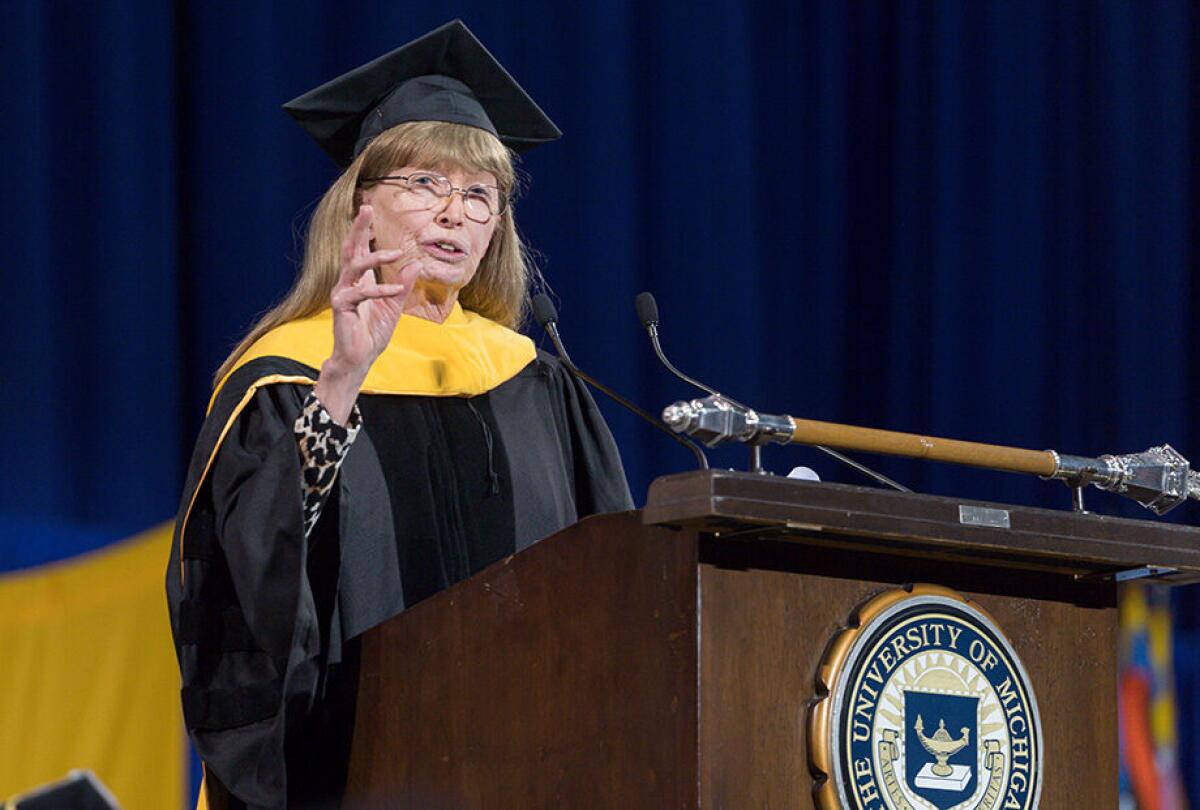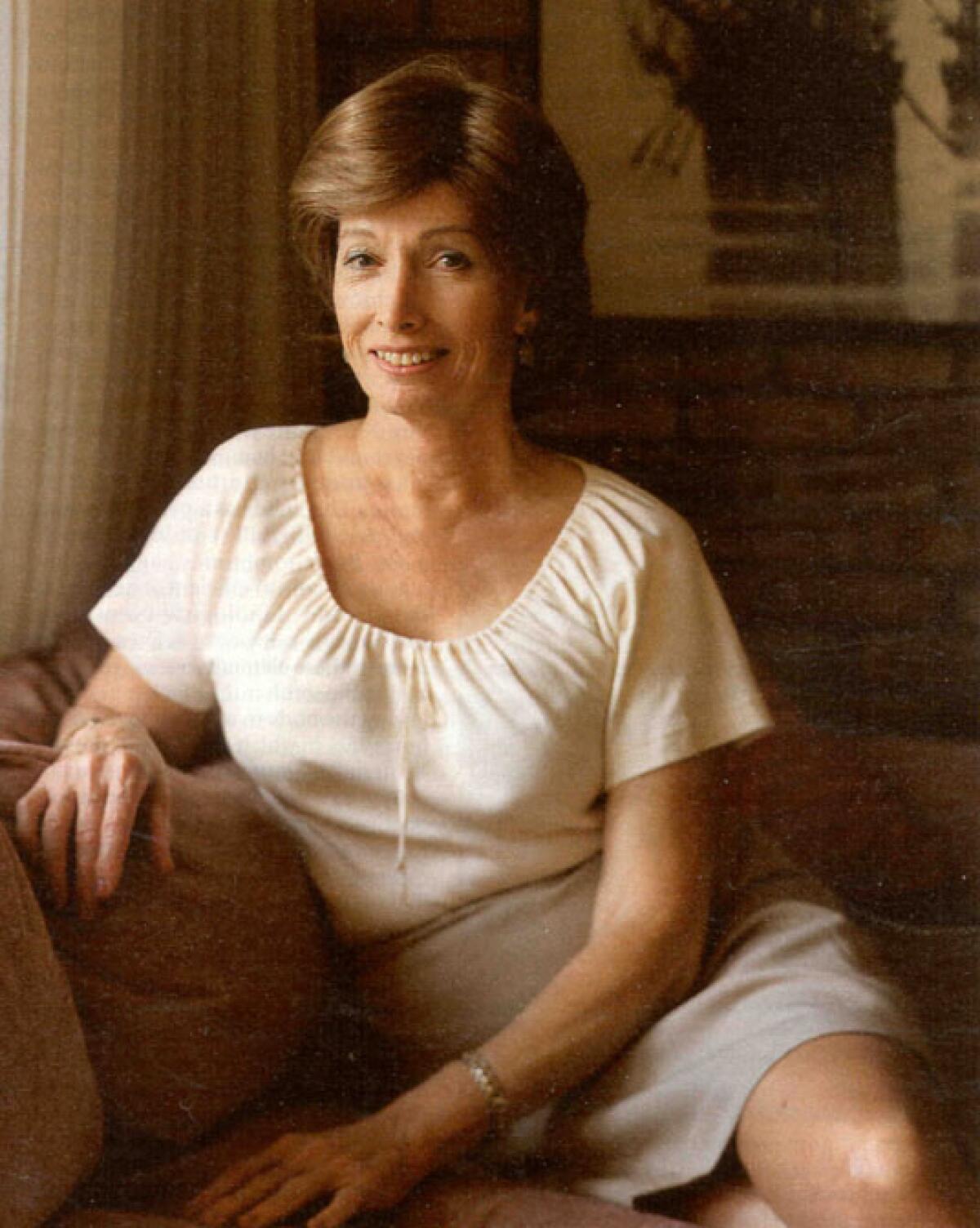Column: IBM apologizes for firing a transgender pioneer, 52 years late

- Share via
On Oct. 14, some 1,200 IBM employees signed on remotely to a company website for what was billed as a celebration of the life and career of Lynn Conway, a “tech trailblazer and transgender pioneer,” as the event was titled.
Conway’s record as a computer science pioneer at IBM and subsequently at Xerox’s Palo Alto Research Center, or PARC, was undoubtedly well known to the attendees, as was the story of her gender transition in 1968.
What was unexpected was that IBM would take the occasion to confess that it had fired Conway in the midst of her transition, after promising to support her — or that it would formally apologize for how it had treated her 52 years earlier.
They thought they were doing the right thing.
— Lynn Conway, on her firing by IBM in 1968
“I wanted to say to you here today, Lynn, for that experience in our company and all the hardships that followed, I am truly sorry,” said Diane Gherson, an IBM senior vice president of human affairs who was leading the event.
“Thanks to your courage, your example, and all the people who followed in your footsteps, as a society we are now in a better place,” Gherson continued. “But that doesn’t help you, Lynn, probably our very first employee to come out. And for that, we deeply regret what you went through — and know I speak for all of us.”
No one was more surprised at the apology than Conway herself, who long ago had shed any resentment about IBM’s actions in 1968.
“I didn’t know how to react,” Conway told me. “I started to tear up. I didn’t know when it started that Diane was going to apologize on IBM’s behalf.”
The event then continued along the lines Conway, 82, had expected — as a recognition not only of her work but the progress the company had made in supporting transgender employees.
“I divide every disagreement into two classes,” Bob Taylor was telling me.
“They are the leading company in this, which is amazing,” she says. She expected the company to merely “admit this happened and they know about my work, and then we would jointly celebrate how far we’ve come.”
To grasp the importance of IBM’s step, it helps to review Conway’s personal and professional journey.

I first met Conway when I was working on my 1999 book about Xerox PARC, “Dealers of Lightning,” for which she was a uniquely valuable source. In 2000, when she decided to come out as transgender, she allowed me to chronicle her life in a cover story for the Los Angeles Times Magazine titled “Through the Gender Labyrinth.”
Growing up male in New York’s strait-laced Westchester County, Conway struggled with an inner turmoil.
A natural engineer, Conway excelled academically and won a place at MIT, but wound up flunking out due to a lack of social or medical support. In 1961, however, Conway enrolled at Columbia University, acquiring bachelor’s and master’s degrees in electrical engineering in only two years.
Conway also impressed a Columbia instructor who was an executive at IBM. That led to a position on a team secretly designing the world’s fastest supercomputer, a pet project of IBM Chairman Thomas Watson Jr.
Conway moved with the team to Menlo Park, Calif., producing engineering innovations that would remain central to IBM’s most advanced computers for years.
It was not so long ago that one could count on certain familiar guideposts of business: Xerox was the dominant provider of office equipment, Sears the biggest retailer, General Electric the leading manufacturer of, well, almost everything, and you couldn’t take a photograph without Kodak.
In the meantime Conway had gotten married and began to raise two daughters. Family life only intensified that inner turmoil, and in 1968 Conway decided to undertake gender reassignment surgery.
As I wrote in 2000, Conway had visualized a nearly seamless transition. IBM would change the name on company records and execute a transfer to another lab, marking a fresh start.
It was not to be. IBM corporate management, unable to see how the secret could be kept from co-workers, feared disruption. Although Conway’s immediate superiors had said they would find room for her at another company lab, contrary orders came down from on high and Conway was quietly fired.
“They thought they were doing the right thing,” Conway told me. “I’m sure in his own mind, T.J. Watson Jr. thought so. He was responsible for a corporation.” Gender transition and sex reassignment surgery were alien concepts at the time.
“Christine Jorgensen was the last time anything had come out about stuff like this,” Conway recalls. Jorgensen’s transition, which had made front-page news in 1951, had been reduced to a historical curiosity nearly two decades later. “Watson was thinking there would be endless publicity, and I can understand that.”
In an era when there was no recourse for anyone fired for sex or gender discrimination, Conway’s job loss could not have come at a worse time.
Conway was living as a woman, but the gender reassignment surgery was not scheduled to take place for a few months. It would cost about $4,000 — an enormous sum in 1968 — not including several thousand dollars in related costs: electrolysis, counseling, hormone therapy.
The family went on welfare for three months. Conway’s wife barred her from contact with her daughters. She would not see them again for 14 years.
Beyond the financial implications, the stigma of banishment from one of the world’s most respected corporations felt like an excommunication.
She sought jobs in the burgeoning electrical engineering community in what would soon become known as Silicon Valley, working her way up through start-ups, and eventually received an offer in 1973 from the research lab Xerox had just established in Palo Alto.
Few executives have moved into new jobs as freighted with history as Tolga Kurtoglu.
PARC has become famous for inventing the personal computer, but Conway’s work was on a different trajectory. In partnership with Caltech engineering professor Carver Mead, she codified the design rules for the new technology of “very large-scale integrated circuits” (or, in computer shorthand, VLSI). The pair laid down the rules in a 1979 textbook that a generation of engineering students knew as “Mead-Conway.”
VLSI fostered a revolution in computer microprocessor design that included the Pentium chip, which would power millions of PCs. Conway spread the VLSI gospel by creating a system in which students taking courses at MIT and other technical institutions could get their sample designs rendered in silicon.
Professional and academic accolades began to accumulate. In 1983, she was recruited to head a supercomputer program at the Defense Department’s Advanced Research Projects Agency, or DARPA — sailing through her FBI background check so easily that she became convinced that the Pentagon must have already encountered transgender people in its workforce. A figure of undisputed authority in some of the most abstruse corners of computing, Conway was elected to the National Academy of Engineering in 1989.
By then she had joined the University of Michigan as a professor and associate dean in the College of Engineering, where she is professor emerita of electrical engineering and computer science. In 2002 she married a fellow engineer, Charles Rogers, and with him has nurtured a 24-acre homestead in a rural district not far from Ann Arbor.
She also became a mentor and model for generations following her path to gender transition. She also has written about how women and minorities can get written out of the histories of scientific and technical innovations — drawing from her own experience of fighting to be recognized for her role in developing VLSI technology.
Conway’s record of professional achievement and personal growth, along with her engineer’s clear-eyed contemplation of the world around her, helped her to look back on her experience at IBM without rancor — “I don’t go around holding grudges,” she says. “That’s just bad karma.”
She was aware, moreover, that IBM had become a leader in its support of transgender employees. But something was missing in her relationship with IBM. The process of filling the vacuum started with Arvind Krishna, who learned the outlines of Conway’s story from a transgender employee shortly after becoming IBM’s CEO in April. He asked Gherson to look into the background.
Her research left her “stunned and heartbroken,” Gherson said at the Oct. 14 event, which incorporated the announcement that Conway had received IBM’s Lifetime Achievement Award.
“While your experience wouldn’t happen today at IBM, there will always be challenges in today’s workplace that we just aren’t prepared for,” Gherson told Conway and the audience.
“One thing 2020 has taught all of us is that we have a lot to learn when it comes to creating an inclusive workplace in society,” Gherson said.“We know there is much work to be done. So we are here today not only to celebrate you as a world-renowned innovator and IBM alum, but also to learn from you — and by so doing create a more inclusive workplace in society.”
For Conway, the event points to a way that society can redress historical wrongs without sweeping them under the rug.
As members of the audience related some of their own experiences of coming out, “the whole thing quickly turned away from recrimination and dissing people who did things in the past that by present standards don’t look very good,” Conway recalls.
“For me personally, it brings a lot of closure,” she says. “It ties things up so that all of that is now ancient history. And it shows a path forward for a lot of issues where there are regrets over past actions. People need resolution, but you can’t go back in space and time and judge those by the techno-social standards of today.
“There are ways of not carrying hate and vendettas, but to be able to historically recognize exactly what happened, and then take away the lessons that any one of us can share about how to avoid entrapping oneself in a similar situation that might be judged in the future. It isn’t really about me. I’m just a messenger.”
More to Read
Inside the business of entertainment
The Wide Shot brings you news, analysis and insights on everything from streaming wars to production — and what it all means for the future.
You may occasionally receive promotional content from the Los Angeles Times.











